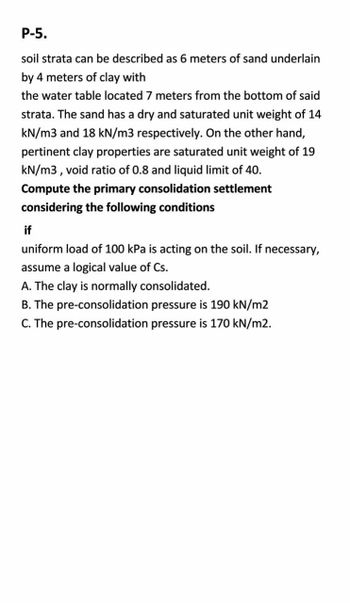
Structural Analysis
6th Edition
ISBN: 9781337630931
Author: KASSIMALI, Aslam.
Publisher: Cengage,
expand_more
expand_more
format_list_bulleted
Concept explainers
Question

Transcribed Image Text:P-5.
soil strata can be described as 6 meters of sand underlain
by 4 meters of clay with
the water table located 7 meters from the bottom of said
strata. The sand has a dry and saturated unit weight of 14
kN/m3 and 18 kN/m3 respectively. On the other hand,
pertinent clay properties are saturated unit weight of 19
kN/m3, void ratio of 0.8 and liquid limit of 40.
Compute the primary consolidation settlement
considering the following conditions
if
uniform load of 100 kPa is acting on the soil. If necessary,
assume a logical value of Cs.
A. The clay is normally consolidated.
B. The pre-consolidation pressure is 190 kN/m2
C. The pre-consolidation pressure is 170 kN/m2.
Expert Solution
This question has been solved!
Explore an expertly crafted, step-by-step solution for a thorough understanding of key concepts.
Step by stepSolved in 3 steps with 3 images

Knowledge Booster
Learn more about
Need a deep-dive on the concept behind this application? Look no further. Learn more about this topic, civil-engineering and related others by exploring similar questions and additional content below.Similar questions
- In a reclamation project, the middle of a clay layer is under an initial effective vertical stress of 200 kPa and initial void The clay is ratio (eo) of 0.90. overconsolidated with OCR of 1.4, compression index of 0.34 and expansion index of 0.07. With an applied load of 299 kPa, what will be the final void ratio (e1) for the clay?arrow_forwardThe soil profile shown below is subjected to a uniformly distributed load (UDL) on ground surface of 600 kN/m². The underground soil consist of two normally consolidated clay (N.C.C.) layers, and between them one sand layer with properties as shown on the figure. If the ground water table is at the ground surface, and the (AP) assumed to be the same at both clay layers, Calculate the total consolidation settlement Sc from the two clay layer? assume compression index, Cc=0.007(LL-10). 4.0 m 3.0 m 2.0 m Clay Sand Clay AP=600 kN/m² W, 35%. LL-40%. G.-2.65 Ys at = 18 kN/m³ W, 40, LL=45%, G,-2.78 ▼ G.W.Tarrow_forwardTwo clay specimens A and B, of thickness 2cm and 3cm, have equilibrium voids rations 0.68 and 0.72 respectively under a pressure of 200 kN/m². If the equilibrium voids ratios of the two soils reduced to 0.50 and 0.62 respectively, when the pressure was increased to 400 kN/m2, find the ratio of the coefficients of permeability of the two specimens. The time required by the specimen A to reach 40 percent degree of consolidation is 14 of that required by specimen B for reaching 40% degree of consolidation? UNIT - 5arrow_forward
Recommended textbooks for you

 Structural Analysis (10th Edition)Civil EngineeringISBN:9780134610672Author:Russell C. HibbelerPublisher:PEARSON
Structural Analysis (10th Edition)Civil EngineeringISBN:9780134610672Author:Russell C. HibbelerPublisher:PEARSON Principles of Foundation Engineering (MindTap Cou...Civil EngineeringISBN:9781337705028Author:Braja M. Das, Nagaratnam SivakuganPublisher:Cengage Learning
Principles of Foundation Engineering (MindTap Cou...Civil EngineeringISBN:9781337705028Author:Braja M. Das, Nagaratnam SivakuganPublisher:Cengage Learning Fundamentals of Structural AnalysisCivil EngineeringISBN:9780073398006Author:Kenneth M. Leet Emeritus, Chia-Ming Uang, Joel LanningPublisher:McGraw-Hill Education
Fundamentals of Structural AnalysisCivil EngineeringISBN:9780073398006Author:Kenneth M. Leet Emeritus, Chia-Ming Uang, Joel LanningPublisher:McGraw-Hill Education
 Traffic and Highway EngineeringCivil EngineeringISBN:9781305156241Author:Garber, Nicholas J.Publisher:Cengage Learning
Traffic and Highway EngineeringCivil EngineeringISBN:9781305156241Author:Garber, Nicholas J.Publisher:Cengage Learning


Structural Analysis (10th Edition)
Civil Engineering
ISBN:9780134610672
Author:Russell C. Hibbeler
Publisher:PEARSON

Principles of Foundation Engineering (MindTap Cou...
Civil Engineering
ISBN:9781337705028
Author:Braja M. Das, Nagaratnam Sivakugan
Publisher:Cengage Learning

Fundamentals of Structural Analysis
Civil Engineering
ISBN:9780073398006
Author:Kenneth M. Leet Emeritus, Chia-Ming Uang, Joel Lanning
Publisher:McGraw-Hill Education


Traffic and Highway Engineering
Civil Engineering
ISBN:9781305156241
Author:Garber, Nicholas J.
Publisher:Cengage Learning